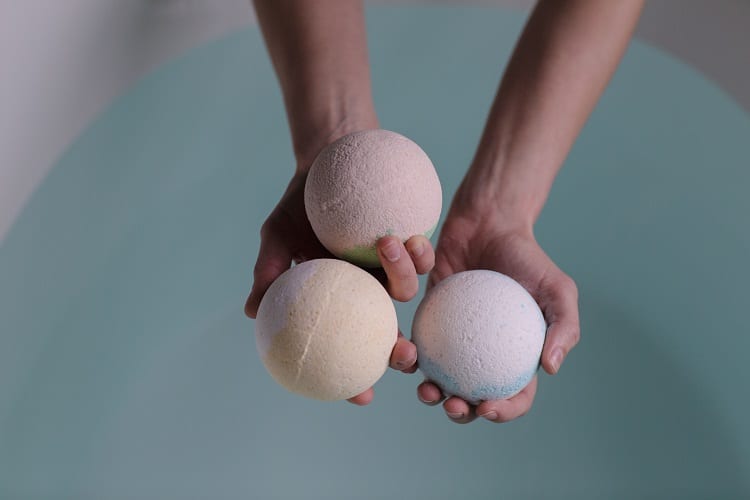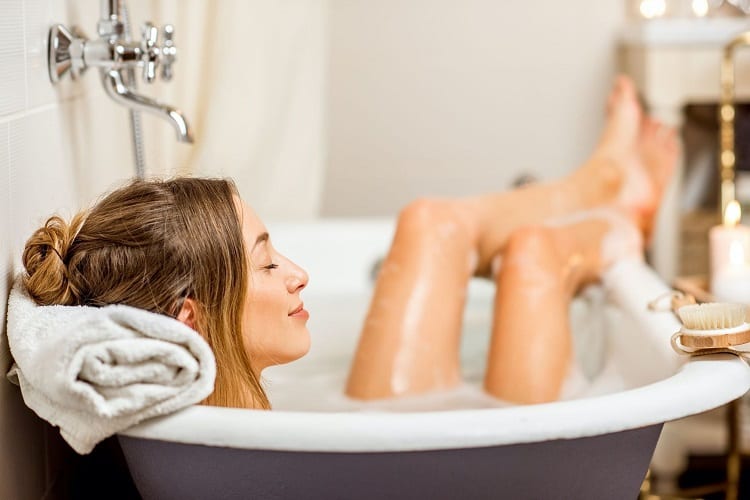You know them as the fun, adult bath products that took away all the shame from bubble baths, but what are bath bombs actually made of? What do they do, and are they dangerous?
We decided to find out. If you already have an Amazon cart filled with Lush products right now, that’s okay; this isn’t some groundbreaking expose or anything like that.
We just want to get the facts straight so that you know what bath bombs are and what they do for your skin.
There’s some good, some bad, and if you have sensitive skin… well, we’ll let you find out as we explain it below.
Contents
History of Bath Bombs

If you feel like you always hear about Lush USA (or just Lush for short) whenever you hear about bath bombs, then you’re not crazy.
Lush co-founder Mo Constantine created bath bombs in 1989, or as she initially called them, “Aqua Sizzlers” (as you can see, the name never caught on).
Her goal was to create something for the bath after watching Alka Seltzer tablets dissolve, or so the legend goes.
While there isn’t a super long history of bath bombs, something interested did happen. When Mo and her co-founder applied for the patent to exclusively make bath bombs, they were accepted… sort of.
They actually lost the patent when they became more of an organization than a simple operation, but in 2014, the couple actually regained their patent (in a sense) for the ability to make bath bombs with specific layers.
That’s why these didn’t really take off until 2014 or so, when everyone hopped on the craze train.
Lush both had to reinvent the wheel and do something unique, which they did (since they’re the gold standard in bath bombs now), but other companies could get in on the mix.
Bath bombs were already fairly popular, but the loss of the patent and revitalization of the original bath bomb in 2014 made the competition fierce, and the trend grew.
Bath Bombs Popularity

You don’t have to be a kid to take a bubble bath anymore. While bath bombs aren’t exactly like taking a bubble bath, they appealed to the self-care and spa community first because they give you a dynamic and hands-free way to deliver minerals and nourishing emollients to your skin.
(By the way, emollients are components of moisturizers responsible for protecting your skin, as well as lubricating it to help it feel soft; they’re a good thing.)
In 2017 alone, over eight million bath bombs were sold. Presumably, we’ll say that’s about half-a-million people. That accounts for those who use them every once in a while, and those who use them regularly.
In 2018, that number nearly doubled to 15.6 million according to the New York Times. At the time of writing this article in the start of 2021, there are tons of predictions about where the bath and shower product market is headed, although it’s currently around 41.5-48 billion dollars. This accounts for more than just bath bombs, but they are a part of that statistic.
They’re popular, and they’re not going away anytime soon. In recent years (namely since the Lush patent in 2014), bath bomb companies have done their part to remove harmful chemicals—which we’ll learn about later on in this article—and secure the future of bath bombs as a safe, viable shower product.
On a final note, keep in mind that a lot of people make DIY bath bombs due to the cost, so we can’t get an ironclad figure on how many people use them since we don’t know how popular they are in the DIY space.
How Are Bath Bombs Made?
If only they had a How It’s Made episode on these, but instead, we have various videos and reading material from around the internet to help us learn just how bath bombs are made. We’re going to summarize the basic way that they’re made right now.
You start with a batch of ingredients: baking soda, essential oils, bubble mix, dye, and hot water. There’s also a sprinkling of citric acid, which is like the glue that keeps everything together.
Baking soda, essential oils, bubble mix, and your dye of choice is all added into a container together. Whoever is handling this should have their hands covered with single-use latex gloves, by the way.
You mix all of this together until it’s the same color and consistency. The oils may take some time to blend in, but it’s not like you’re going to use an entire ounce, so that’s okay. This is also a good time to add any emollients that you can find, such as mineral oil.
Once it’s all mixed together, you use a small mold to make a circle of pure baking soda. Compact it until it’s all put together. Go back to the main dyed mixture and add your citric acid, mix it around, and then fill two halves of a bath bomb mold together.
Place that little ball of pure baking soda in the center so that it sits like a Kinder Egg surprise in the center of the bath bomb, push the two pieces together, and you’re good to go. Compact it, unwrap it, and drop it in the bath.
How to Use Bath Bombs Properly?
Bath bombs are dead simple to use. All you have to do is get the right water temperature to really make them work. According to Lush USA, “Fill your bathtub with warm water, then drop the bath bomb in and enjoy the show!”
They say that because it begins to fizz up immediately. The trick here is making sure the water is warm and not hot, otherwise you’ll end up going through the bath bomb emollients far too quickly, and you won’t get the skin-softening benefits.
The ideal temperature should be 92°F, which is considered the perfect warm temperature. Test the water by dipping your wrist in (not your hands) so you’ll be able to properly gauge the temperature. Then, drop your bath bomb in and climb right into the tub.
Health Concerns
We have three main health concerns to go over, and while they’re mostly situational, you really should pay attention to these just in the off chance you encounter either of these problems.
For your skin, you may encounter irritation. This is mostly only with sensitive skin types. Emollients soften the skin, but to do that they first need to be absorbed on the surface level of your epidermis.
That’s good, and it makes your skin soft, but with sensitive skin your list of irritants is much longer than someone with a normal skin type.
You may experience itching, redness, or slight swelling on the skin from inflammation. This doesn’t mean you can never use bath bombs again, but that you might have to experiment and find a different one with different properties.
Parabens are usually the trigger, and many bath bombs do include them (they serve their purposes in manufacturing, but they’re not ideal for your skin).
The second issue is pH balance within a woman’s vagina. As a general rule, women aren’t supposed to take bubble baths or use bath products that can alter the good bacteria of their vagina. Bath bombs fall within that category.
Now, is it okay to use one every once in a while?
Sure, you’re not going to undo all of the good bacteria that your body has produced in a short amount of time.
But don’t overstay your welcome in the bathtub, and don’t use bath bombs too often. Apart from health concerns, they can also rack up to quite a hefty sum after using them more than once per week.
Finally, we run into certain chemical uses and their links to cancer and lowered hormone production in the male and female body.
Some bath bombs contain aldehydes and phthalates, which are both linked to risks of cancer including ovarian cancer, as well as embryo-related problems, liver disease, and respiratory allergies.
Yeah, you can form allergies from using phthalate-enriched bath bombs. Thankfully, you’ll find that a lot of manufacturers are taking these out of their bath bombs, but not all of them. Pay attention to the packaging.
The Best Way to Take a Bath
Bath bombs add so much more to your bath time experience. They’re not something you use for a casual, quick bath before bed, but if you have the time to lean back and soak in the nutrients, enjoy the sensation, and simply just let your troubles drift away, then they’re perfect.
It’s like a miniature spa day for your skin. Relaxation plus beneficial emollients and softeners for your skin? That sounds like luxury, and if you’ve never experienced a bath bomb before, then you’re missing out. Check out our buying guide on the best bath bombs on the market to treat yourself.
